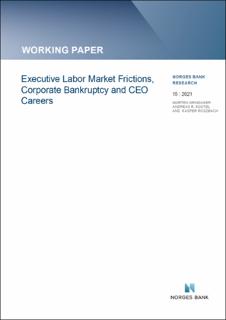| dc.contributor.author | Grindaker, Morten | |
| dc.contributor.author | Kostøl, Andreas R. | |
| dc.contributor.author | Roszbach, Kasper | |
| dc.date.accessioned | 2021-12-28T06:43:35Z | |
| dc.date.available | 2021-12-28T06:43:35Z | |
| dc.date.issued | 2021 | |
| dc.identifier.isbn | 978-82-8379-214-0 | |
| dc.identifier.issn | 1502-8190 | |
| dc.identifier.uri | https://hdl.handle.net/11250/2835492 | |
| dc.description.abstract | CEOs of large firms filing for bankruptcy are more likely to exit the executive labor market after bankruptcy and experience substantial compensation losses (Eckbo et al., 2016). While the fear of reputational scarring can lead to lower risk-taking and manifest itself as lower rates of entrepreneurship and job growth, the mechanisms through which bankruptcy affects CEO careers are not well understood. In this paper, we examine the effect of "random bankruptcy" decisions on small and medium-sized business CEOs’ careers. By random, we mean job separation for reasons unrelated to a firm or CEO quality but rather through a court’s bankruptcy decision. We control for the unobserved ability of bankrupt and non-bankrupt CEOs by using randomly assigned judges’ propensity to liquidate firms as an instrument. We then combine our sample of CEOs with administrative records containing granular information on income, wealth, new employers and job titles. Our results show that bankrupt CEOs find new employment quickly, but that a large share exits the executive labor force. On average, bankruptcy reduces CEOs’ variable income components. While the net present value of CEOs’ loss of future capital income equals more than 60 percent of annual pre-bankruptcy income, we observe no effect on wage income. We find that displaced CEOs are more likely to reallocate to new industries and new geographic areas, suggesting that managerial skills are portable. We explore how the income and employment effects of bankruptcy vary with industry conditions. Consistent with the executive labor market using bankruptcy as a noisy signal of managerial ability, we find the displacement effect is stronger when industry conditions are good. Our evidence is consistent with the presence of information frictions that could entail important social costs. | en_US |
| dc.language.iso | eng | en_US |
| dc.publisher | Norges Bank | en_US |
| dc.relation.ispartofseries | Working paper;15/2021 | |
| dc.rights | Attribution-NonCommercial-NoDerivatives 4.0 Internasjonal | * |
| dc.rights.uri | http://creativecommons.org/licenses/by-nc-nd/4.0/deed.no | * |
| dc.subject | occupational choice | en_US |
| dc.subject | bankruptcy | en_US |
| dc.subject | CEO | en_US |
| dc.subject | organizations | en_US |
| dc.subject | executive compensation | en_US |
| dc.subject | JEL: G33 | en_US |
| dc.subject | JEL: J24 | en_US |
| dc.subject | JEL: K22 | en_US |
| dc.subject | JEL: L29 | en_US |
| dc.subject | JEL: M12 | en_US |
| dc.title | Executive Labor Market Frictions, Corporate Bankruptcy and CEO Careers | en_US |
| dc.type | Working paper | en_US |
| dc.description.version | publishedVersion | en_US |
| dc.subject.nsi | VDP::Samfunnsvitenskap: 200::Økonomi: 210::Samfunnsøkonomi: 212 | en_US |
| dc.source.pagenumber | 35 | en_US |

